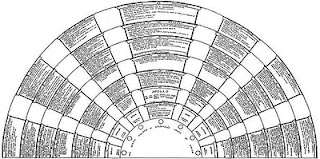Definition of the Composite
Any body, assumed under a determined name, is divisible, as we consider it act of the body.
Definition of the Whole and the Part
In the whole the part is identified by any thing you individuate as smaller than the whole; the whole is that which results as a composite of all the parts.
Definition of the Figure
The figure is that which is limited by a curved line or by more than two straight lines, that is, a
determined proportion of body and plane.
De Minimo IV, vii, 284-287
…………………………………………
To this end, the process of bringing the materials together (orchestration) in the
minimum
is not of composition but is determined by squeezing, wrapping
endlessly, creasing within and over creases, compressing into each
other, shoving upward and downward, pressing out from the sides, staging
all processes that bring together through the dynamics of forces risen
between materials and masses, yield and stress, nonlinear elasticity and
flow plasticity: an architectural forge-press.
Reza Negarestani
……………………………
digital dark ages
A famous real example is with NASA, whose early space records have suffered from a Dark Age issue more than once. For over a decade, magnetic tapes from the 1976
Viking Mars landing
were unprocessed. When later analyzed, the data was unreadable as it
was in an unknown format and the original programmers had either died or
left NASA. The images were eventually extracted following many months
of puzzling through the data and examining how the recording machines
functioned














